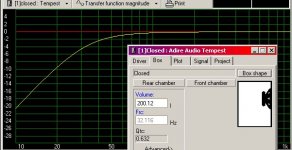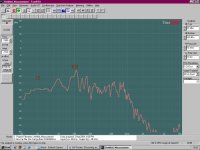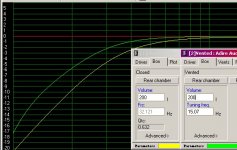First! You won't experience room gain at higher frequencies. Only in the bass area....
As to my knowledge, room gain +3dB only applies at full wavelenght.... And can easily be calculated
As to my knowledge you can use room gain to gain your bass output from the speakers as follows:
- Speaker up against a wall +3dB
- Speaker up against a wall in a corner +6dB
- Speaker up against a wall in a corner an on floor +9dB
As to my knowledge, room gain +3dB only applies at full wavelenght.... And can easily be calculated
As to my knowledge you can use room gain to gain your bass output from the speakers as follows:
- Speaker up against a wall +3dB
- Speaker up against a wall in a corner +6dB
- Speaker up against a wall in a corner an on floor +9dB
That's not really room gain, that's loading into half/quarter/eighth space. The room gain I'm talking about is when the mode changes from wavelength reproduction to pressure mode. This gain rises as frequency goes down, hence my question on the slope. But thanks for the answer still 
I've heard conflicting stories on the things I've questioned in my original post, hence the request for real, verified information.
I've heard conflicting stories on the things I've questioned in my original post, hence the request for real, verified information.
Adire Audio did a room gain curve in a 50m^3 room (4m x 5.5m by 2.3m), it's around +5 dB octave when corner loaded, starting at around 300 Hz.
Page 4 of this document: http://www.adireaudio.com/Files/VentedShivaApplications.PDF
Page 4 of this document: http://www.adireaudio.com/Files/VentedShivaApplications.PDF
Here's a simulation of RobWells' sealed sub, Qtc = 0.75, according to WinISD:
http://www.diyaudio.com/forums/attachment.php?postid=366440&stamp=1081327935
Here is the measured response in the room:
http://www.diyaudio.com/forums/attachment.php?postid=366441&stamp=1081328162
So the room gain is substantial.
Here is the thread these are from:
http://www.diyaudio.com/forums/showthread.php?postid=366440#post366440
http://www.diyaudio.com/forums/attachment.php?postid=366440&stamp=1081327935
Here is the measured response in the room:
http://www.diyaudio.com/forums/attachment.php?postid=366441&stamp=1081328162
So the room gain is substantial.
Here is the thread these are from:
http://www.diyaudio.com/forums/showthread.php?postid=366440#post366440
Richie,
Something you've got to keep in mind is that room gain is very dependant upon your room (it's volume, shape, dimensions, boundary construction, how well it is sealed, what kind of furniture you have in your room to absorb bass, etc.). Count on some gain in your design and then make the final tuning decisions based on actual in room response.
Something you've got to keep in mind is that room gain is very dependant upon your room (it's volume, shape, dimensions, boundary construction, how well it is sealed, what kind of furniture you have in your room to absorb bass, etc.). Count on some gain in your design and then make the final tuning decisions based on actual in room response.
I copied this from one of my projects:
Anechoic response curve, 1 speaker, on axis
In room response, 2 speakers
The room response image has 2 curves, one with no gating and one with a 4ms window. Describing the conditions: 2 meter equilateral triangle consisting of 2 speakers and a microphone. The offset tweeters are to the outside. The speakers are not toed in; they face straight ahead and as such are off axis to the mic. The room is 16 ft x 18ft. The speakers are on the 16 foot wall, mounted on 24" stands and the baffles are 28" out from the rear wall. The mic is level with the tweeters. There is no absorbtive material on the rear wall. Between the speakers is a 51" big screen TV, which the inside edge of the speakers cleared by about a foot. The room has a cathedral ceiling which, when facing the speakers from the mic location, goes from 8 feet on the left side to 13 feet on the right side. The right side front corner has a large opening leading to another room, and the right side rear corner has another opening leading to another room. The room is carpeted, contains a couch, a love seat and other pieces of furniture. The left side is moderately absorbant with blinds and curtains, and the right side (with the openings) is very reflective from a stone fireplace. Construction is traditional drywall. Whew. I think that covers it.
I think the important factors for the bottom two octaves, in order, are the room size, placement within the room and then openings to other rooms affect the very bottom octave. It's hard to generalize room response. Everything affects everything.
Anechoic response curve, 1 speaker, on axis
In room response, 2 speakers
The room response image has 2 curves, one with no gating and one with a 4ms window. Describing the conditions: 2 meter equilateral triangle consisting of 2 speakers and a microphone. The offset tweeters are to the outside. The speakers are not toed in; they face straight ahead and as such are off axis to the mic. The room is 16 ft x 18ft. The speakers are on the 16 foot wall, mounted on 24" stands and the baffles are 28" out from the rear wall. The mic is level with the tweeters. There is no absorbtive material on the rear wall. Between the speakers is a 51" big screen TV, which the inside edge of the speakers cleared by about a foot. The room has a cathedral ceiling which, when facing the speakers from the mic location, goes from 8 feet on the left side to 13 feet on the right side. The right side front corner has a large opening leading to another room, and the right side rear corner has another opening leading to another room. The room is carpeted, contains a couch, a love seat and other pieces of furniture. The left side is moderately absorbant with blinds and curtains, and the right side (with the openings) is very reflective from a stone fireplace. Construction is traditional drywall. Whew. I think that covers it.
I think the important factors for the bottom two octaves, in order, are the room size, placement within the room and then openings to other rooms affect the very bottom octave. It's hard to generalize room response. Everything affects everything.
Zaph,
How can you get that kind of data with a 4ms window? Shouldn't 250Hz be the lowest measurable point?
Kelticwizard,
Do you feel that RTA'd pink noise is the best measurement technique for the bottom octave? I've never been able to match 1/30 octave warbles to 1/30 octave pink noise RTA, and haven't any idea which is more accurate.
How can you get that kind of data with a 4ms window? Shouldn't 250Hz be the lowest measurable point?
Kelticwizard,
Do you feel that RTA'd pink noise is the best measurement technique for the bottom octave? I've never been able to match 1/30 octave warbles to 1/30 octave pink noise RTA, and haven't any idea which is more accurate.
tiroth said:Zaph,
How can you get that kind of data with a 4ms window? Shouldn't 250Hz be the lowest measurable point?
I used a 200ms window for the room response, but it also has a 4ms on there for comparison. Obviously, you can tell which one has the 4ms window.
John
Hi All,
Just to add a note that the measurements above were taken at seating position, and If you move back a few feet you can hear the bass drop in and out a bit due to room modes.
They were for the bass units in my mains btw
My tempests are here:
http://www.diyaudio.com/forums/show...&highlight=diy+versus+servo+subs&pagenumber=9
Here's a winISD plot of their predicted response Q will be lower due to stuffing however.
Cheers,
Rob
Just to add a note that the measurements above were taken at seating position, and If you move back a few feet you can hear the bass drop in and out a bit due to room modes.
They were for the bass units in my mains btw
My tempests are here:
http://www.diyaudio.com/forums/show...&highlight=diy+versus+servo+subs&pagenumber=9
Here's a winISD plot of their predicted response Q will be lower due to stuffing however.
Cheers,
Rob
Attachments
Tiroth,
I have a spl meter, and it would be interesting to try warble tones with it. However my gut response is that the ECM8000 mic, with the calibration file in trueRTA should be more accurate than the spl meter. Sadly I couldn't get hold of the radioshack analogue meter, which does have some calibration spreadsheets available on the web. (snapbug site for example)
If I can find some decent warble tones I'll do a comparison if you like.
Cheers,
Rob
I have a spl meter, and it would be interesting to try warble tones with it. However my gut response is that the ECM8000 mic, with the calibration file in trueRTA should be more accurate than the spl meter. Sadly I couldn't get hold of the radioshack analogue meter, which does have some calibration spreadsheets available on the web. (snapbug site for example)
If I can find some decent warble tones I'll do a comparison if you like.
Cheers,
Rob
So if you try and ignore the room mode peaks at 50 and 100Hz on the tempest, and draw an average curve through it you will end up with the 15Hz measurent being approx 10dB above the simulated response, and this concurs with my scan speaks aswell (the ones Kelticwizard posted earlier)
My room is 21' long, 10' wide and 7' 6" high at each end, raising to 8' 7" in the middle (like this __/^^^^\__ )
It doesn't have solid brick walls. I think they're old type lathe and plaster walls.
Does this agree with the math models ?
Cheers,
Rob
My room is 21' long, 10' wide and 7' 6" high at each end, raising to 8' 7" in the middle (like this __/^^^^\__ )
It doesn't have solid brick walls. I think they're old type lathe and plaster walls.
Does this agree with the math models ?
Cheers,
Rob
Here is my predicted room gain curve:
For the sub response I used Qtc=0.63 and F3 I guessed from the graph at 35Hz. So here is my predicted sub response with room gain:
An externally hosted image should be here but it was not working when we last tested it.
For the sub response I used Qtc=0.63 and F3 I guessed from the graph at 35Hz. So here is my predicted sub response with room gain:
An externally hosted image should be here but it was not working when we last tested it.
Richie00boy,
Your predicted room gain is only a couple of dB over my actual at 15Hz. I believe at these freq's the room is pressurised by the speakers, and my walls will flex way more than brick walls. (lowering gain)
I've read of some people claiming that as there are losses due to air leaks, non solid walls etc, as JohninCR stated, that an ebs type ported sub is a much better match for real world flat response. Indeed if I was to ebs my tempests I probably wouldn't need to eq them (for boost at least - only to flatten)
For me it would mean building new cabs though, and I'm still not 100% sure on ported designs.
Rob
Your predicted room gain is only a couple of dB over my actual at 15Hz. I believe at these freq's the room is pressurised by the speakers, and my walls will flex way more than brick walls. (lowering gain)
I've read of some people claiming that as there are losses due to air leaks, non solid walls etc, as JohninCR stated, that an ebs type ported sub is a much better match for real world flat response. Indeed if I was to ebs my tempests I probably wouldn't need to eq them (for boost at least - only to flatten)
For me it would mean building new cabs though, and I'm still not 100% sure on ported designs.
Rob
Attachments
Alternative model room gain:
Alternative model room gain with same sub response as before:
This one is a bit closer to what you measured I think.
An externally hosted image should be here but it was not working when we last tested it.
Alternative model room gain with same sub response as before:
An externally hosted image should be here but it was not working when we last tested it.
This one is a bit closer to what you measured I think.
Thats pretty spot on. I'd imagine the only way to do proper sims would be to build several rooms the same dimension but using different construction techniques, and measuring.
I'd imagine the only way to do proper sims would be to build several rooms the same dimension but using different construction techniques, and measuring.
Then you could define construction types before you modelled.
The graph I always used was linked to here :
http://www.diyaudio.com/forums/showthread.php?s=&threadid=1261&highlight=
Which in my case underestimated room gain.
Cheers,
Rob
Edit..Wouldn't it be great if there was a really cheap 12" driver available everywhere that modelled to a low Q in a tiny box ? Then we could all build one and measure as many rooms as possible and build up a spreadsheet or something to make a proper modelling program. I know I know, the differences in measuring equipment would kill it... sigh
Then you could define construction types before you modelled.
The graph I always used was linked to here :
http://www.diyaudio.com/forums/showthread.php?s=&threadid=1261&highlight=
Which in my case underestimated room gain.
Cheers,
Rob
Edit..Wouldn't it be great if there was a really cheap 12" driver available everywhere that modelled to a low Q in a tiny box ? Then we could all build one and measure as many rooms as possible and build up a spreadsheet or something to make a proper modelling program. I know I know, the differences in measuring equipment would kill it... sigh
Rob,
Your comments about EBS are intriguing. I myself am considering building a new 140L box for my shiva...I'll see if I like it better ported or sealed. I've yet to find a sub that I am really happy giving a lot of power to at 20Hz...I think the excursion reduction in the bottom octave might be worth it despite the downsides of a ported design.
Your comments about EBS are intriguing. I myself am considering building a new 140L box for my shiva...I'll see if I like it better ported or sealed. I've yet to find a sub that I am really happy giving a lot of power to at 20Hz...I think the excursion reduction in the bottom octave might be worth it despite the downsides of a ported design.
- Status
- This old topic is closed. If you want to reopen this topic, contact a moderator using the "Report Post" button.
- Home
- General Interest
- Room Acoustics & Mods
- Room Gain in Real Life


